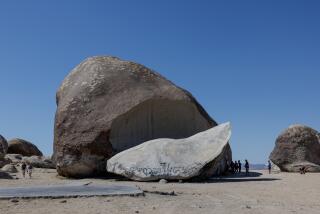Ethereal Piedra Blanca a Link to Sorcerers Past : Outdoors: Monolith held to be a Chumash Indian spiritual refuge.
- Share via
A drive through the Rose Valley area of the Los Padres National Forest provides the usual assortment of breathtaking nature cliches--purple-mountain majesty, awe-inspiring waterfalls, babbling brooks--but none of those sights adequately prepare you for Piedra Blanca.
Piedra Blanca is a massive sandstone formation, a white horizontal slash across a background of dark green mountains. When you descend into a small valley on a narrow road and see the monolith for the first time, you’re struck with a sense of disorientation, the feeling that you’ve somehow entered an alien world.
A geological phenomenon--the rocks are actually fossilized sand dunes that are 65 million years old--Piedra Blanca is a popular hiking destination because of its otherworldly appearance, but that is not the only reason for its appeal. According to local lore, Chumash Indians considered Piedra Blanca a spiritual place. Exactly what went on there beyond contemplation and stargazing is not known, but it is historical fact that the mountains in this area were the last stronghold of native sorcery and the last refuge of Indians escaping missionary influence.
“Mellow out,” Tom Grubbs tells his noisy friends. “This is like a religious place.”
Grubbs, a Malibu cinematographer, and four friends are sitting on a huge outcropping deep within Piedra Blanca. They are in the middle of a sprawling white bowl a quarter-mile wide and filled with white boulders of varying sizes, some as big as apartment buildings. Although manzanita thrives on the sandy floor of the bowl, nothing grows on the tops of the rock, giving it a cold, stark, frothy appearance.
When the hikers quiet down, all they can hear are the gentle westerlies. For big-city refugees, the silence is startling. “The absence of sound is such a sweet feeling,” Grubbs says. Looking out beyond the rim and across to distant peaks, the awed hikers feel a oneness with the Chumash.
“It’s so serene,” Grubbs says. “I feel very centered here.”
Unlike other hiking trails, the Piedra Blanca National Scenic Trail pays off with a quasi-religious experience. Surrounded by the white rock, one is almost required to be reverent and discuss philosophical subjects in a respectful whisper.
Getting to the white rock, however, can be a frustrating experience punctuated by primal screams. Although the trail head is simple to find, the trail immediately disappears. First-timers can get lost easily, wander aimlessly for a half-hour in search of the true trail and then quit in disgust, still in sight of their car.
“When you miss the entrance to the trail, the rest of your day is spent in the brush,” says Hillary Young of Ventura, who had to abandon her hike.
If you know where to look, the trail is not difficult to find. The trail head is at the back of Lion Campground, which is north of Ojai an hour’s drive from Ventura. A well-marked U.S. Forest Service sign directs hikers down an embankment and across Sespe Creek. Unfortunately, spring floods wash out all traces of the trail in the creek bed, so first-timers don’t know where to pick it up on the far side of the river.
That problem can be avoided, however, before the hike even starts. At the trail-head sign, look across the Sespe to the opposite bank. Turn your head a little to the right and you will see another Forest Service sign. That’s where the trail continues.
Find a good place to boulder-hop across the creek and follow the sign to Piedra Blanca. The trail meanders uphill to Pine Mountain, nine miles away, and connects with the Bear Trap Trail, forming an 18.2-mile route with an elevation gain of more than 3,200 feet. Day hikers, however, can reach the white rocks in only 30 minutes of easy walking up a modest incline.
In the winter and spring, check beforehand with the Forest Service whether the trail is accessible--it is not unusual to have flooding and snow.
The path to the white rocks follows the dry Piedra Blanca Creek over typical high-desert terrain consisting of manzanita, sagebrush, mountain mahogany and an occasional pinon pine. Almost as soon as you see Piedra Blanca from the trail you are in the boulder bowl, faced with the giddy dilemma of what to explore first.
A labyrinth of pathways leads everywhere, often to the edge of a cliff. Caves in small gorges can be accessed without too much trouble, but your biggest urge will be to run to the top of an outcropping and play king of the hill.
With a little luck, you will see a young condor on a reconnaissance mission from the nearby sanctuary. Then you will feel compelled to lie back on the white rock--and get philosophical.
More to Read
Sign up for The Wild
We’ll help you find the best places to hike, bike and run, as well as the perfect silent spots for meditation and yoga.
You may occasionally receive promotional content from the Los Angeles Times.






